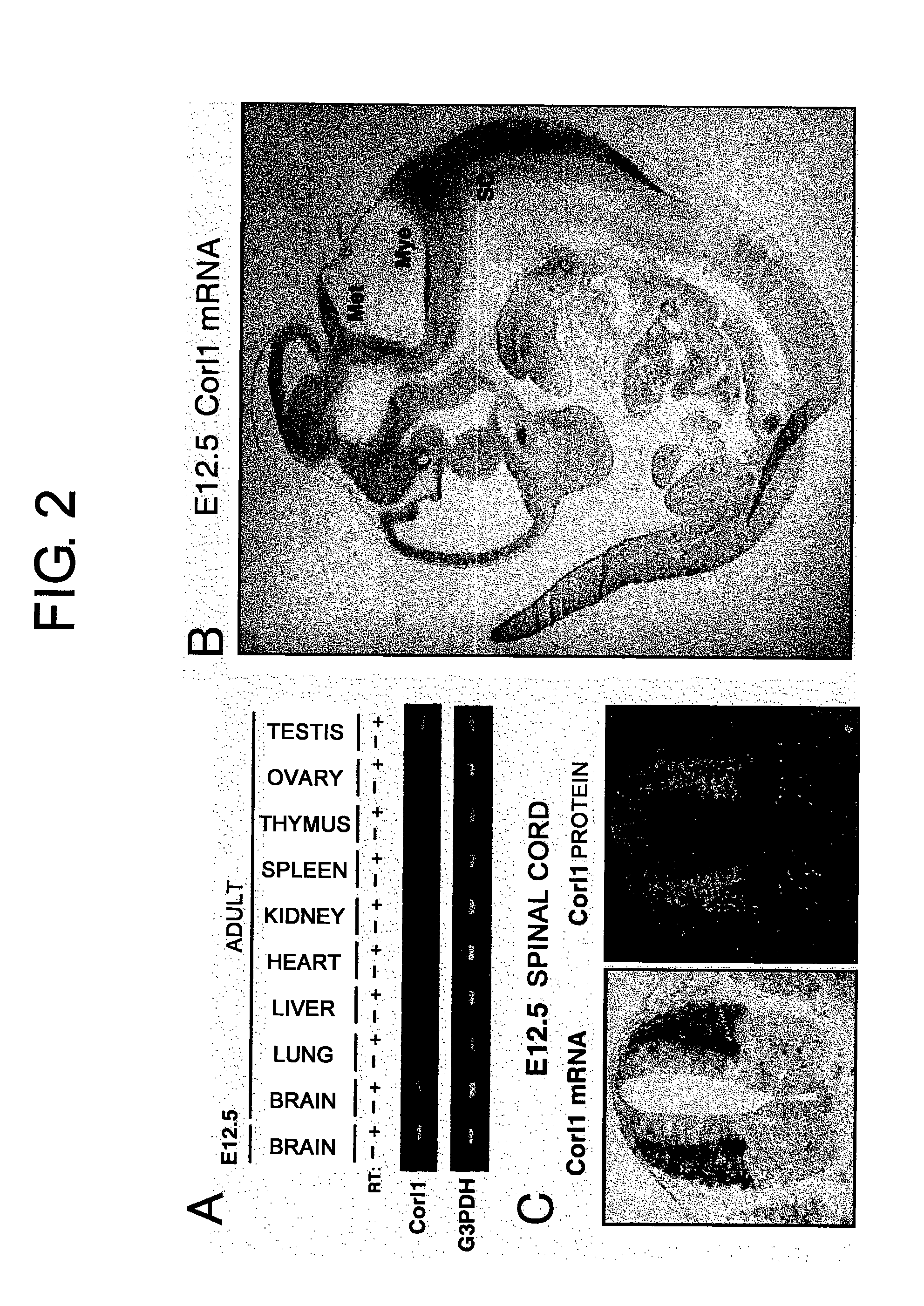Methods of Distinguishing Types of Spinal Neurons Using Corl1 Gene as an Indicator
a technology of corl1 and spinal nerve, applied in the field of corl1 gene, can solve the problem that no known marker is able to distinguish between di4 and di6
- Summary
- Abstract
- Description
- Claims
- Application Information
AI Technical Summary
Benefits of technology
Problems solved by technology
Method used
Image
Examples
example 1
Isolation and Sequencing of Corl1
[0180]Genes whose expression levels were different between the ventral and dorsal regions of E12.5 mouse midbrain were identified by the subtraction (N-RDA) method to isolate embryonic brain region-specific genes. One of isolated fragments was a cDNA fragment encoding a protein whose function was unknown.
1 N-RDA Method
1-1. Adapter Preparation
[0181]The following oligonucleotides were annealed to each other, and prepared at 100 μM: (ad2: ad2S+ad2A, ad3: ad3S+ad3A, ad4: ad4S+ad4A, ad5: ad5S+ad5A, ad13: ad13S+ad13A)
ad2S:cagctccacaacctacatcattccgt(SEQ ID NO: 61)ad2A:acggaatgatgt(SEQ ID NO: 62)ad3S:gtccatcttctctctgagactctggt(SEQ ID NO: 63)ad3A:accagagtctca(SEQ ID NO: 64)ad4S:ctgatgggtgtcttctgtgagtgtgt(SEQ ID NO: 65)ad4A:acacactcacag(SEQ ID NO: 66)ad5S:ccagcatcgagaatcagtgtgacagt(SEQ ID NO: 67)
[0182]ad5A: actgtcacactg (SEQ ID NO: 68)
[0183]ad13S: gtcgatgaacttcgactgtcgatcgt (SEQ ID NO: 69)
[0184]ad13A: acgatcgacagt (SEQ ID NO: 70).
1-2. cDNA Synthesis
[0185]Ventr...
example 2
Analysis of Corl1 Expression
[0207]In the next step, the expression of Corl1 was analyzed. First, the expression in tissues of adult mouse was analyzed by RT-PCR.
[0208]Single-stranded cDNA was synthesized from total RNA of each tissue (Promega) using RNA PCR kit (TAKARA), which was used as a template. The thermal cycling profile used was as follows: 2 minutes of incubation at 94° C., 35 cycles of 94° C. for 30 seconds, 65° C. for 30 seconds, and 72° C. for 30 seconds, followed by incubation at 72° C. for 2 minutes. The composition of PCR mixture used was as follows:[0209]10× buffer 1 μl[0210]2.5 mM dNTP 0.8 μl[0211]ExTaq 0.05 μl[0212]100 μM primer 0.1 μl[0213]cDNA 1 μl[0214]distilled water 7.05 μl[0215]primer sequence
Corl1 F2:ATGCAGAGAGCATCGCTAAGCTCTAC(SEQ ID NO: 73)Corl1 R2:AAGCGGTTGGACTCTACGTCCACCTC(SEQ ID NO: 74)
[0216]The results revealed that Corl1 was expressed specifically in adult brain and testis (FIG. 2). It was also revealed that the expression level in the brain was higher...
example 3
Analysis of Corl1 expression in spinal neurons induced from ES cells in vitro
[0227]To examine whether Corl1 can be used to identify in vitro differentiated spinal neurons, the expression of Corl1 in spinal neurons induced from ES cells was analyzed according to the following protocol.
[0228]CCE cells, an undifferentiated ES cell line, were suspended at a cell density of 1000 cells / 10 μl in Glasgow Minimum Essential Medium (Invitrogen) supplemented with 10% Knockout serum replacement (Invitrogen), 2 mM L-glutamine (Invitrogen), 0.1 mM Non-essential amino acid (Invitrogen), 1 mM sodium pyruvate (sigma), 0.1 mM 2-mercaptoethanol (sigma), 100 U / ml penicillin (Invitrogen), and 100 μg / ml streptomycin (invitrogen). 10 μl of the cells was placed onto the cover of plastic dish. The dish was inverted and incubated at 37° C. under 5% CO2 and 95% humidity for 2 days. Then, formed embryoid bodies (EB) were collected in the above-described medium. 2 μM retinoic acid (RA) (sigma) was added alone or...
PUM
| Property | Measurement | Unit |
|---|---|---|
| Volume | aaaaa | aaaaa |
| Volume | aaaaa | aaaaa |
| Volume | aaaaa | aaaaa |
Abstract
Description
Claims
Application Information
 Login to View More
Login to View More - R&D
- Intellectual Property
- Life Sciences
- Materials
- Tech Scout
- Unparalleled Data Quality
- Higher Quality Content
- 60% Fewer Hallucinations
Browse by: Latest US Patents, China's latest patents, Technical Efficacy Thesaurus, Application Domain, Technology Topic, Popular Technical Reports.
© 2025 PatSnap. All rights reserved.Legal|Privacy policy|Modern Slavery Act Transparency Statement|Sitemap|About US| Contact US: help@patsnap.com



